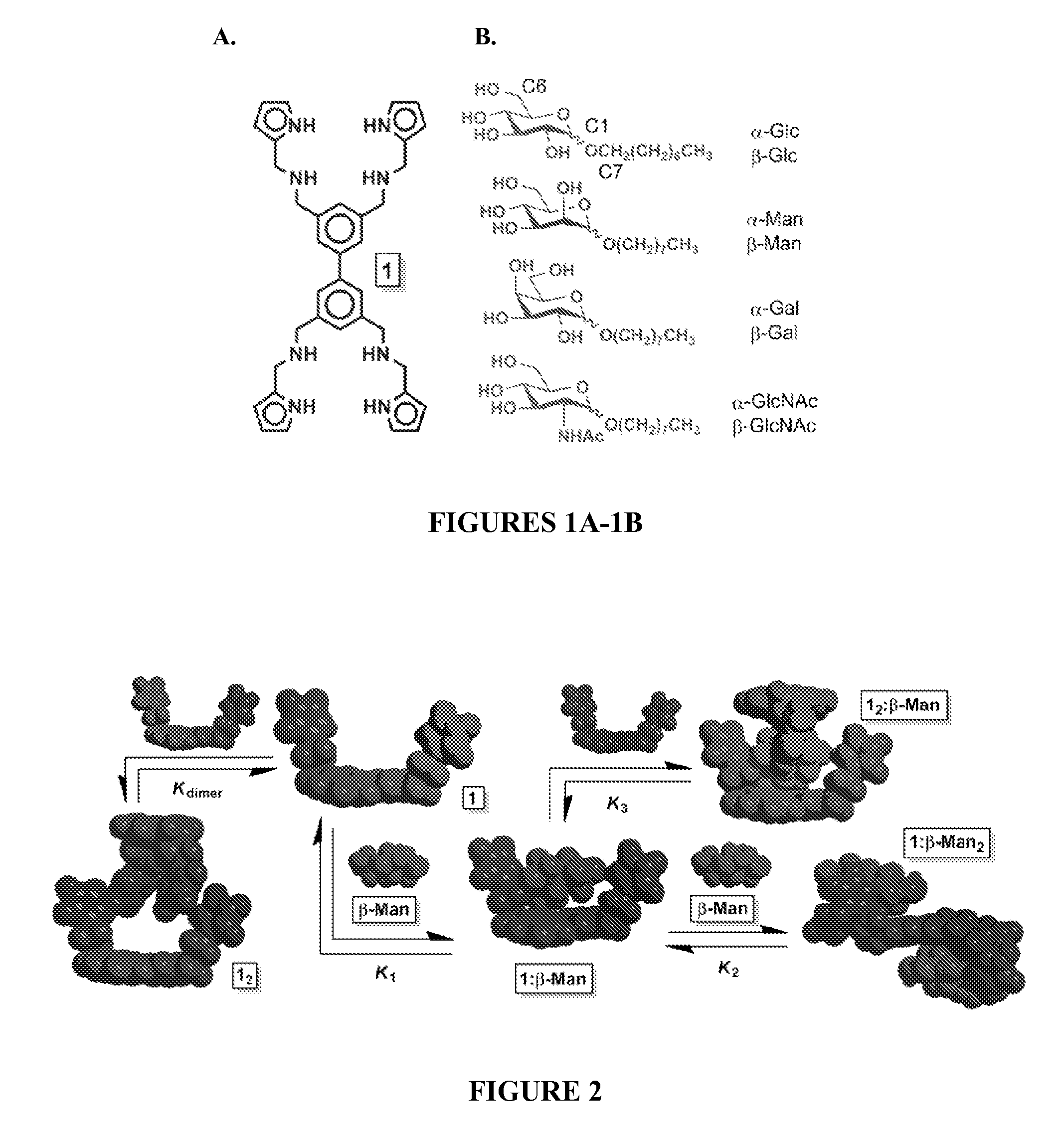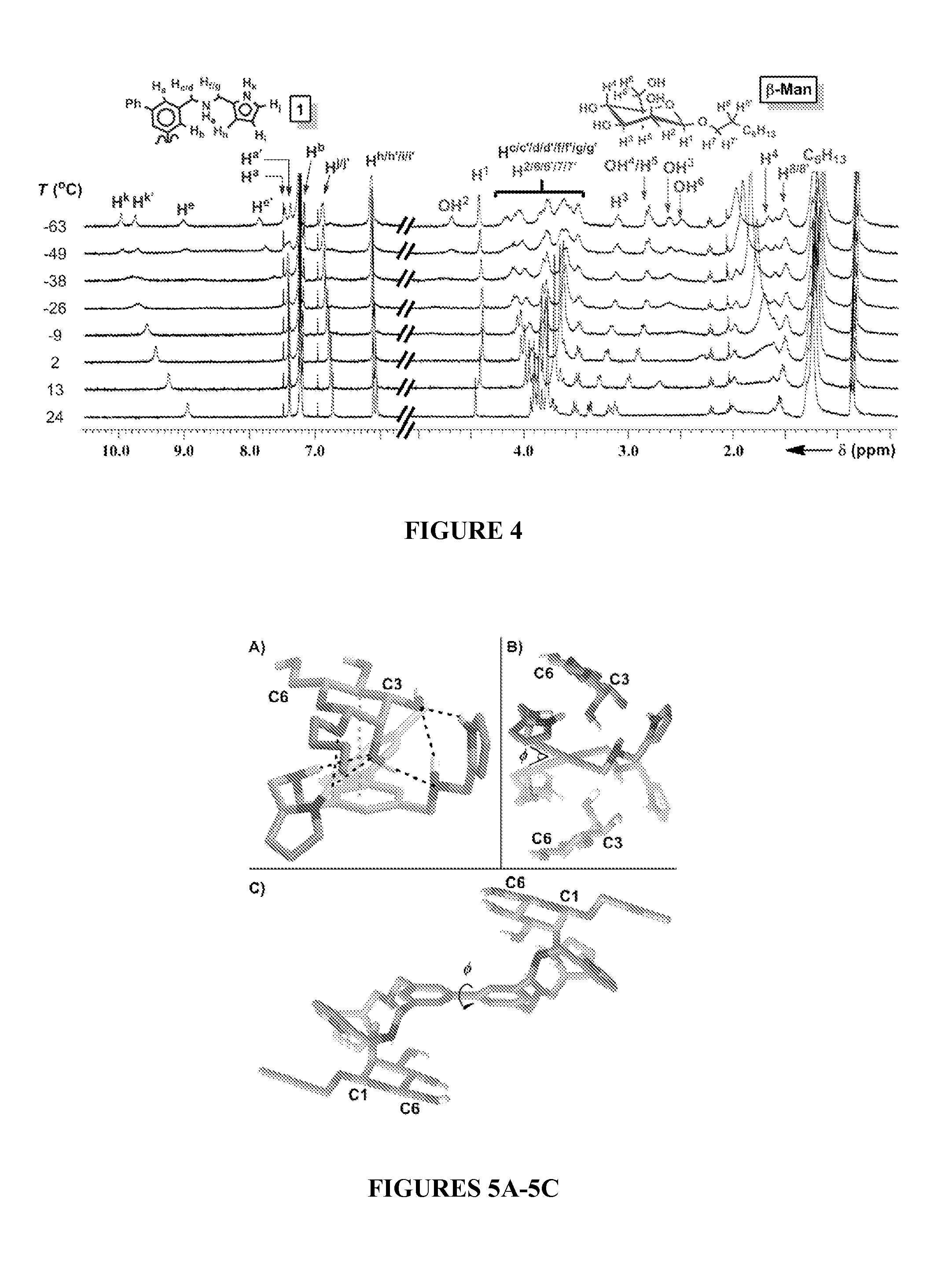Carbohydrate-selective receptors
a carbohydrate receptor and selective technology, applied in the field of synthetic carbohydrate receptors, can solve the problems of difficult recognition of monosaccharides possessing axial hydroxyl groups, such as mannose, by this approach, and achieve the effects of enhancing the binding of saccharide, enhancing the binding strength and specificity, and enhancing the binding of the same substra
- Summary
- Abstract
- Description
- Claims
- Application Information
AI Technical Summary
Benefits of technology
Problems solved by technology
Method used
Image
Examples
example 1
Carbohydrate Receptor Synthesis
[0233]Receptor 1 was prepared in a five step synthetic sequence from 1,3-bis(bromomethyl)-5-iodobenzene 2 in a 64% overall yield (Scheme 5). After substitution to provide diazide 3, a one-pot Suzuki coupling of two equivalents of 3 yielded tetra-azide 4. An aza-Wittig reaction between 4 and 1H-pyrrole-2-carbaldehyde furnished tetra-imine 5, which finally produced receptor 1 upon reductive amination with NaBH4. The reactions were characterized by 1H NMR, 13C NMR, and high resolution mass spectrometry, and all spectra were consistent with the proposed structures (see FIGS. 10-12).
[0234]
example 2
Pyranoside Binding
[0235]The binding affinity and selectivity of 1 for eight octylpyranosides (FIG. 1), which were chosen as guests, because they are common terminal residues found on cell surface glycol-conjugates and are used as standards for assaying synthetic receptor selectivity (ESSENTIALS OF GLYCOBIOLOGY (Ajit Varki et al. eds., Cold Spring Harbor Laboratory Press 1999); Werz et al., ACS Chem. Biol. 2:685-691 (2007), which are hereby incorporated by reference in their entirety), were investigated by variable temperature 1H NMR titrations in CDCl3. Chloroform facilitates the binding studies of new carbohydrate receptors (Davis & Wareham, Angew. Chem. Int. Ed. 38:2978-2996 (1999); Mazik, RSC Adv. 2:2630-2642 (2012); Mazik, Chem. Soc. Rev. 38:935-956 (2009); Jin et al., Med. Res. Rev. 30:171-257 (2010), which are hereby incorporated by reference in their entirety) because the solvent does not compete for hydrogen bonding between host and guest, thereby enhancing polar noncovalent...
example 3
1:2 Receptor:Pyranoside Binding
[0236]The quantification of Kdimer, K1, K2, and K3 from a single 1H NMR titration experiment under the fast exchange regime is possible by fitting the chemical shift changes, Δδ, but the large number of fitting parameters often results in multiple points of convergence (Thordarson, Chem. Soc. Rev. 40:1305-1323 (2011), which is hereby incorporated by reference in its entirety). Thus, the binding of pyranosides was first studied under conditions where receptor 1 was maintained at a low concentration (dimer and K3 equilibria (FIG. 2). Once the values of K1 and K2 were determined, their values were held invariant in subsequent peak shift fittings, which facilitated the quantification of the other Kas. The incremental addition of a 10-12 mM solution of each of the eight octylpyranoside to a dilute solution of 1 (58.6 μM) induced changes in the 1H NMR chemical shifts corresponding to the protons of 1, owing to a fast exchange between bound and unbound substr...
PUM
 Login to View More
Login to View More Abstract
Description
Claims
Application Information
 Login to View More
Login to View More - R&D
- Intellectual Property
- Life Sciences
- Materials
- Tech Scout
- Unparalleled Data Quality
- Higher Quality Content
- 60% Fewer Hallucinations
Browse by: Latest US Patents, China's latest patents, Technical Efficacy Thesaurus, Application Domain, Technology Topic, Popular Technical Reports.
© 2025 PatSnap. All rights reserved.Legal|Privacy policy|Modern Slavery Act Transparency Statement|Sitemap|About US| Contact US: help@patsnap.com



